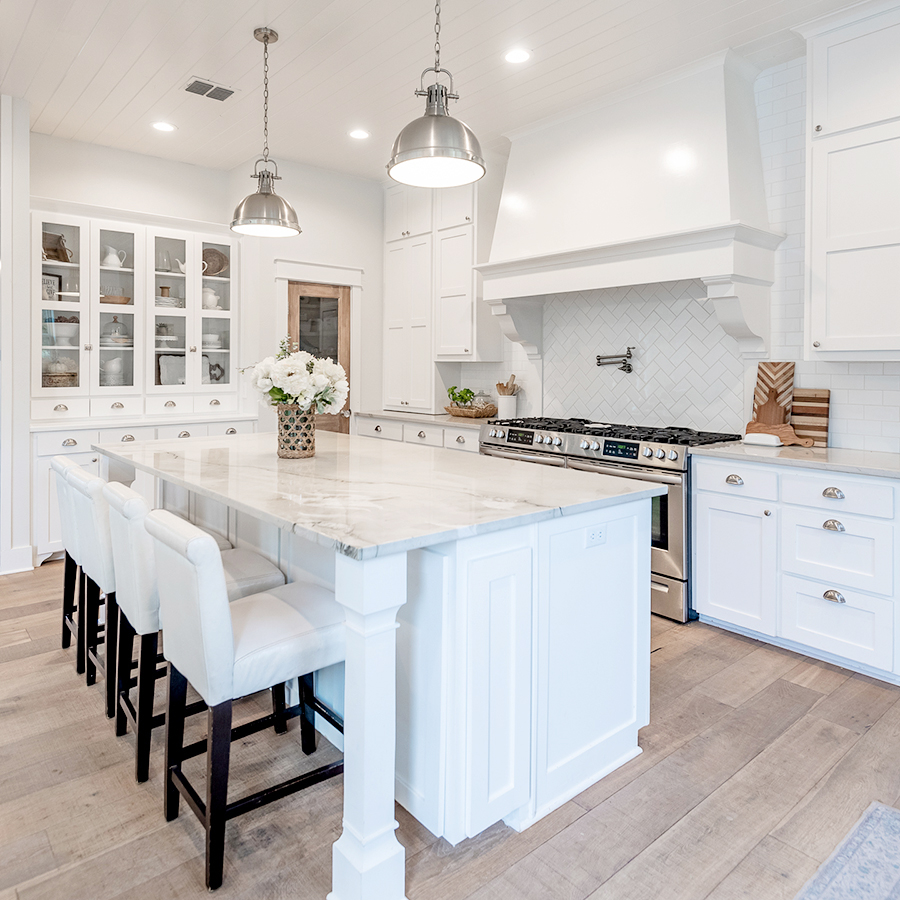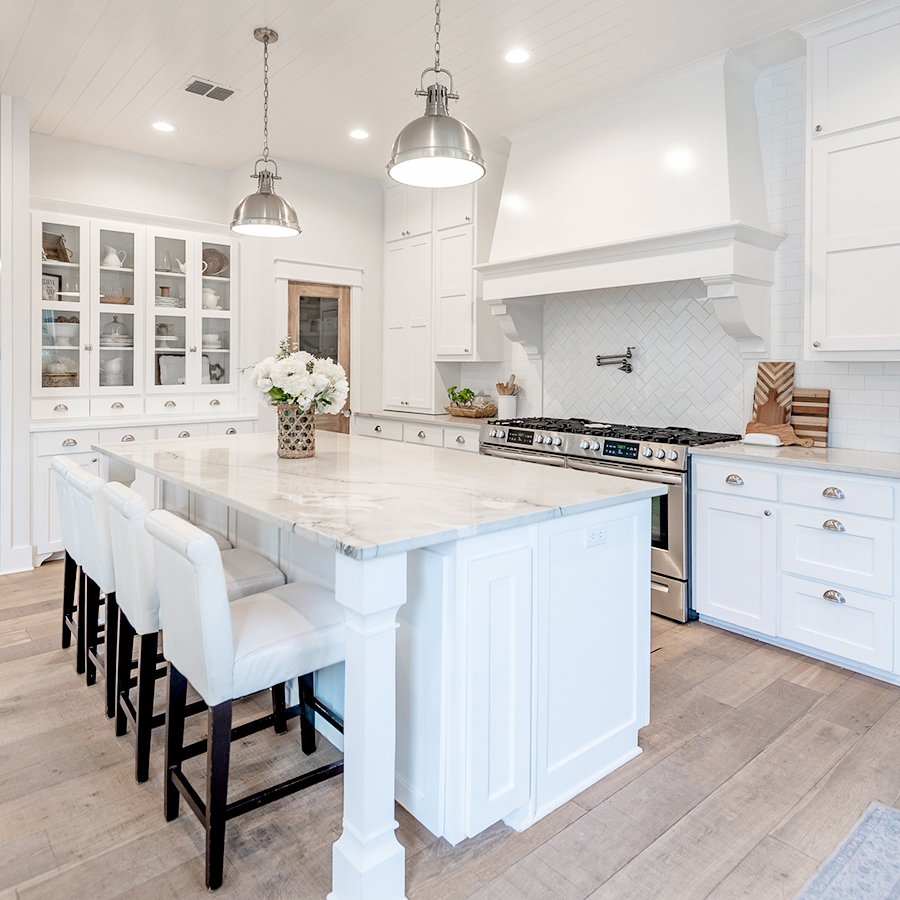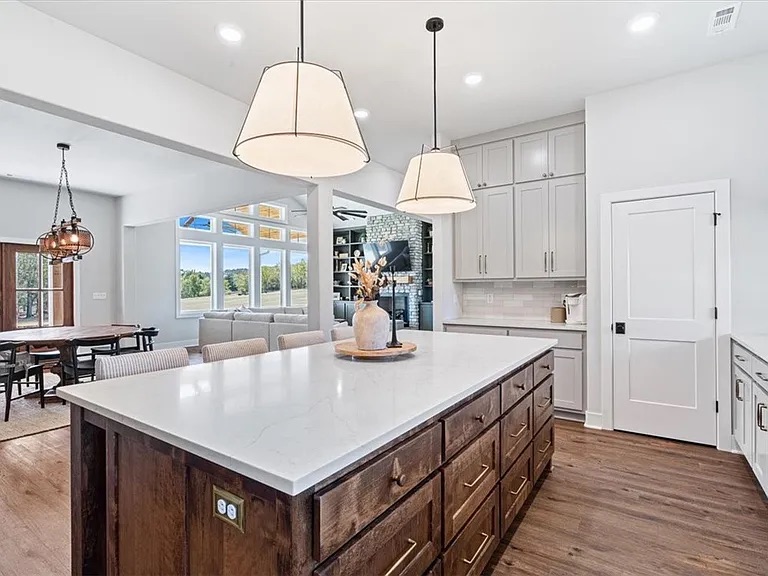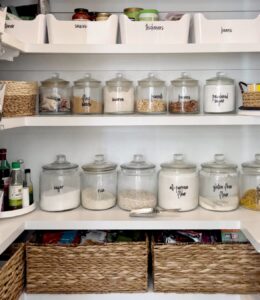
Everything You Need to Know about Cabinets

Over the past few months, we’ve talked about all sorts of seemingly small decisions that impact your home build in huge ways. Today, let’s talk about your choice of cabinets!
In your kitchen, your cabinets are the crown jewel. They have the biggest influence on the aesthetic and functionality of your space. Their reign doesn’t have to end there, though! There are other spots in your home where you could install cabinets to elevate your home’s vibe and functionality. Cabinets can be an absolute game changer in any functional space – so it’s important you choose wisely!
“What is there to think about when choosing cabinets, though? Shouldn’t I just pick ones that I think are pretty?” I hear you ask. Great question! While you might be tempted to just pick some that you think look nice in your home, picking the wrong cabinets can actually contribute to disorganization and clutter in your home, which can put unnecessary stress on you and your family.
In this blog, we’ll let you in on your options for cabinets, how much you should spend on them, and helpful tips for making them work for you. Read on to learn more about picking cabinets that work for YOU!

Save or Splurge on cabinets?
First of all, let’s talk about how much you should invest on your cabinets.
We’ve previously talked about which aspects of your home build are worth splurging on and which ones you can save on. To make this list, we polled our audience for real feedback from people who have built their dream home. We also shared our own insights based on our own experiences.
With that in mind, we firmly believe you should splurge on your kitchen cabinets. Cabinets are incredibly difficult to replace. You’ll have to remove all of your current cabinets, potentially redo the electric and plumbing behind your cabinets, fit new cabinets to your space, and then either install them yourself or hire someone to install them.
This process is time consuming, costly, and messy, rendering your kitchen basically useless for the duration of the project. Avoid this hassle by picking high quality cabinets you love the start!
Moreover, replacing your cabinets most likely means replacing your countertops to match, which only adds to the cost and chaos. If you read our previous guide to countertops,this could be especially dissapointing since almost no two slabs of any material are exactly alike.
The exception to this rule applies to cabinets in smaller and less visible areas of the home, such as guest bathrooms, the laundry room, or the mudroom. These spaces typically have fewer cabinets in them than the kitchen and generally get less foot traffic, making them ideal spots to save on cabinetry.

Cabinet Materials
Before you pick your cabinets, you will want to know all of your options. Each of these options will have different pros and cons, so consider what qualities are important for you when deciding what cabinet material suits your needs best!
Some of the most popular cabinet materials include:
Wood
Wood cabinets are a classic choice. If you want finished wooden cabinets, go with a hardwood such as oak, maple, hickory, or walnut. Poplar and birch are typically cheaper, but they are softer woods and slightly less durable than their hardwood counterparts.
PROS: More durable than any other material, available in a variety of woods/stains, classic look
CONS: Expensive, wood can warp over time, time consuming to sand/restain for remodels, require consistent care/maintenance
Wood Veneer
If you like the look of hardwood cabinets but your budget doesn’t allow for them, consider wood veneer. These cabinets are made by bonding hardwood to cheaper cuts of wood, giving them an expensive look at a lower cost.
PROS: Affordable option with a luxurious visual appeal, lightweight, classic look, more durable than most other options
CONS: Less durable than hardwood, may chip over time
Plywood
Plywood cabinets are made by combining thin pieces of wood with pressure or adhesive. It is a common choice for kitchen cabinets because it is both durable and relatively inexpensive, so this is a good option to consider under a tight budget.
PROS: Easy to clean and maintain, budget-friendly, high water resistance
CONS: Less durable than wood/wood veneer, may chip over time, susceptible to warping
Laminate
Laminate cabinets are made of synthetic material. With these types of cabinets, you will have a hard time getting a wood-like finish, so it’s best to simply paint laminate cabinets.
PROS: One of the least expensive options, easy to clean, available in may different styles
CONS: Break more easily than other materials, susceptible to water damage
High-Density Fiberboard (HDF)
Similar to plywood and laminate, HDF is a synthetic material. It’s made by mixing wood fibers with resin and glue, making it quite sturdy. It’s also less expensive than real wood options, making it both an economical and durable choice.
PROS: Hard to damage, budget-friendly, easy to paint
CONS: Susceptible to water damage, cannot achieve natural wood look, less durable than other options
While there are other cabinet materials you could use, these are some of the most popular choices. Use this list as a launching point as you narrow down what types of cabinets you’d like for your home!
Generally, we recommend investing in higher-quality cabinets for your kitchen and other spaces in your home that get a lot of foot traffic. For less commonly used rooms, you can opt for cheaper options to save more money on your build.
Tips for Perfect Cabinets
Now that we’ve covered the basics, let’s talk about some practical ways to make your cabinets as functional as possible. After all, your home design should make your life easier, not harder!
All of these tips are things we’ve learned through our own home builds and through helping others bring their dream home to life over the past few years. We hope these tips will help you, too, as you select cabinets for your dream home!
1. Use cabinets to declutter
We often think of cabinets as basic storage spots for miscellaneous items in whatever room they are in. However, if we take this idea to the next level, you can strategically use your cabinet space to keep your home clean and tidy!
In our mudroom, we’ve installed tall cabinets with doors for each member of the family to store coats, shoes, and other similar items. With three kids, you can imagine things get pretty hectic pretty quickly! However, the doors on the cabinets make it easy to just toss their things into the cabinet to keep the space tidy.
We also use cabinets to store certain kitchen appliances, which frees up a TON of counter space. For example, we have a coffee cabinet in our kitchen that houses our coffee machine, coffee, and other supplies, making it easily accessible AND out of sight.
2. Do NOT use a matte finish on painted cabinets
When choosing a finish for painted cabinets, you have the option to pick from the following, in order from the most matte to the least: flat, eggshell, satin, semi-gloss, and full gloss.
When it comes to cabinets – especially in the kitchen – we recommend going with semi-gloss or gloss. Although the matte finish is pretty and trendy, you will regret it in the long run! Matte paint is incredibly hard to keep clean, so unless you want to spend time cleaning your cabinets every single day, that beautiful matte finish will not be beautiful for long.
In contrast, semi-gloss and gloss finishes are incredibly easy to clean and maintain. While they might not look quite as chic as a matte finish, they will save you a lot of time and energy. Plus, they are classic finishes that will keep your kitchen timeless!
Additionally, in our experience, we have found that factory-finished paint is typically superior to on-site cabinet painting. In the factory, they can paint in a dust-free environment, allow for proper dry time, and get a hard-shell finish that is much more durable than most on-site paint jobs.
It’s also essential to use the right primer and paint. Kitchens and bathrooms get a lot of moisture, so you need a paint finish that can endure water damage. For this reason, we sometimes recommend pre-fabricated cabinets over fully custom.
If you choose to paint your cabinets on-site for budget reasons, try using pre-catalyzed lacquer. We had a client do this recently with stunning results!
3. Install drawers on lowers and adjustable shelves in uppers
Have you ever found that over time, your cabinets get less and less organized? When you first moved into your home, you probably had each set of pots and pans neatly placed together, each set of Tupperware stacked and organized, each utensil in a proper place. Now, though, if you were to open your cabinets, you see chaos.
I totally get it – life happens, people put things in the wrong place, and over time, your cabinets become disorganized. This isn’t made easier by the fact that you have to crouch, kneel, or even get on the floor to reach certain items in the very back of your lowers!
Make organization easier for yourself by installing sliding drawers on your lower cabinets instead of cabinet doors. These drawers are easier to access and easier to keep organized, which will save you a lot of time and agitation in the long run.
Plus, sliding drawers are more accessible than cabinet doors. As you age, there’s a possibility that you or someone else in your family could experience disability, changes in mobility, or other things that would affect how you navigate your home. For that reason, it’s good to think about implementing universal design elements into your home now so that you don’t have to make drastic changes later.
To maximize function in your upper cabinets make sure you have adjustable height shelves so you can make sure tall item fit, and there’s not a bunch of wasted space above shorter items.
4. Inset vs. overlay vs full overlay, frameless vs. framed
When choosing doors for your cabinets, you’ll have a couple different options. These choices will affect both the look and functionality of your cabinets, so it’s important to weigh them carefully.
First, decide between overlay and inset doors. Overlay doors sit on top of your cabinets, while inset doors sit flush with the cabinet. While inset cabinets hide your cabinet door hinges, they are often more expensive than overlays, require more maintenance, and reduce the amount of storage space you have. Overlay doors do not look as high end as inlay cabinet doors, but they are cheaper, more durable, and still have a classic look to them.
Additionally, choose between framed and frameless cabinets. Framed cabinets have a more sound structure, which makes them more durable and provides flexibility in door sizes and hinge types. Additionally, they offer a more traditional look. However, the frame slightly reduces the accessible storage space, and the visible frame might not appeal to those seeking a sleek, modern aesthetic.
On the other hand, frameless cabinets offer a more contemporary, clean look with seamless doors and edges. They maximize storage space, making them a great choice for the sake of functionality. However, frameless cabinets rely on thicker, more rigid materials for support, which makes them more expensive than framed cabinets. Additionally, they may be less durable over time.
5. Store items strategically
Arrange frequently used items within easy reach, and stash rarely used ones in hard-to-reach cabinets.
In our family, I use our kitchen the most. I keep daily essentials like pots, pans, and certain appliances in lower cabinets, as the upper ones are out of my reach. Infrequent items? Upper cabinets, where I can get Cody’s help or a step stool when needed!
Additionally, consider the visibility of your cabinets. We have a hutch with glass doors and open shelving below it that sits above our kitchen countertops.Here, we display attractive tableware and decorative pieces, adding beauty to the room. Using cabinets with glass or open shelving for ornate dishware not only keeps less-used items out of the way but also enhances your kitchen’s aesthetic appeal!
6. Create a pullout cabinet for your trash can
You’ve put in a lot of hard work to create your dream kitchen, so don’t let a trash can spoil it!
Sure, a stainless steel trash can looks better than plastic, but it still hogs space and can stink up the room. Stashing it in the pantry helps, but then you’re constantly trekking back and forth.
The solution? A pull-out trash can inside a cabinet! It keeps the trash accessible yet out of sight. Popular spots are by the kitchen sink or in the kitchen island, but go with what suits your family best. Since our sink is not in the island, I wanted the trash pullout in the island so I could have a place at each surface to wipe crumbs into.
Happy Choosing!
Having the right cabinets is key to creating the perfect kitchen for your dream home. Now that you know how to pick them, we’re sure you’ll be brimming with excitement and confidence!
Building a home on a budget can be tricky, but our Bootstrap Builders Program is here to help. By cutting out the middleman and acting as your own general contractor, you can save 25% or more on your build. This responsibility may seem daunting, but our program provides all the information needed to make your project a success!
Have any questions? We’re here to help you get started! Feel free to reach out today!
